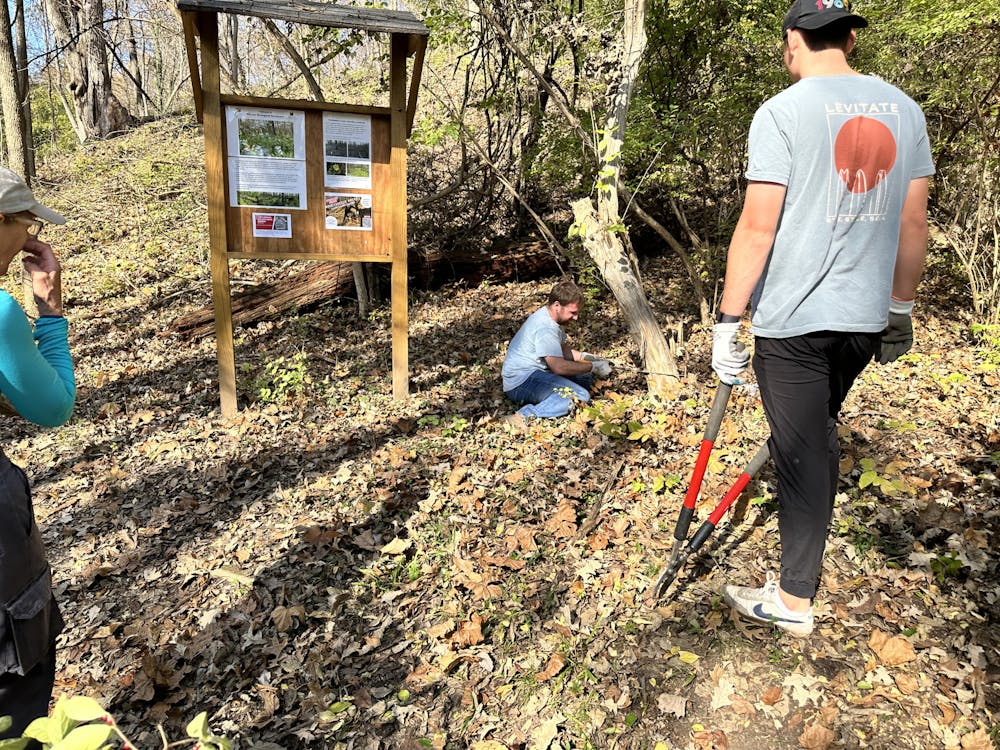On the western edge of Peffer Park lies an extensive wildflower garden and nature preserve housing a colorful array of plant species and hiking trails. On Saturday, Nov. 4, Miami University students and faculty descended on the Silvoor Biological Sanctuary to cut down invasive honeysuckle plants and survey the landscape.
The day was defined by clear skies and heaps of fallen leaves and the sanctuary full of lime green honeysuckle shrubs with red berries. Although these plants seem beautiful compared to the withering and dormant plants around them, Amur honeysuckle is an invasive species that threatens the livelihood of native plants in the area.
Amur honeysuckle is native to the Amur River Valley in China but came to the United States at the beginning of the 20th century for ornamental reasons. The shrub has spread rapidly into wildlife habitats and taken away sunlight and soil from native plants.
“We have a high canopy with native trees and forest floors for wildflowers, but not a lot of shrubbery that takes that middle space,” said Amanda Bentley Brymer, the assistant director of the Institute for the Environment and Sustainability and the primary organizer of the event. “The honeysuckle was able to take advantage of that and spread all over the tri-state area.”
Bentley Brymer, whose house is adjacent to the sanctuary, often walks through with her kids and dog and notices the spreading of honeysuckle in the sanctuary. This empowered her to do something about it.
The volunteers at the Honey Hack consisted of neighbors, science majors and outdoor pursuits students looking to make a difference in their community.
The process of removing the honeysuckle consists of cutting and laying down the shrub, then applying herbicide to the stump, which spreads to the roots and prevents further growth. Bentley Brymer emphasized how this method, compared to foliar application, distributes less herbicide and lessens damage to the ecosystem.
“Some people ask: why do we use herbicide in a wildflower sanctuary? But honeysuckle is so quick to resprout if we don’t dabble a little herbicide on the stump,” said Bentley Brymer.
The timing of the event is also critical to preserving the habit. Hosting the event while the wildflowers are dormant helps decrease the likelihood of causing damage to the ecosystem.
Students continued supporting biodiversity in the sanctuary by taking a profile of the area’s tree composition. By profiling the area’s biodiversity, the institute can better plan what new native wildflowers to plant in the following years.

Miami professor David Gorchov instructs students on how to survey tree composition.
Laurel Dennis, a junior majoring in botany and co-majoring in environmental science, was one of the students profiling the native species at the sanctuary.
Enjoy what you're reading?
Signup for our newsletter
“I originally came here to clear the honeysuckle … but then I got sucked into tree surveys, which I’ve never done before,” Dennis said. “It’s a good learning experience for me.”
Other restoration efforts at the sanctuary include reinforcing an eroding trail section, bringing back more wildflowers, repurposing a broken dam and interpretative signing for increased learning opportunities.
“Doing our part to improve these ecosystems and correct some mistakes that were made in the past helps build community with people,” said Byrmer. “No matter where you live … if there is a group enjoying the outdoors, [chances are] that group is going to be involved with removing invasive plants.”
The Silvoor Biological Sanctuary hosts annual wildflower walks for eight consecutive Sundays between March and May. A botanist at Miami leads the walks and hosts activities for adults and children.
David Gorchov, a biology and ecology professor, cited the wildflower walks as one of the main reasons the sanctuary and honeysuckle hack are important.
“I think the wildflower walks are a great entry for adults, students and children to get interested in nature,” said Gorchov. “People will be a lot more conscientious about nature after that.”

Cut stems of bush honeysuckle
The next honeysuckle hack will occur on Dec. 2, from 12-3 p.m. at the Silvoor Biological Sanctuary.




